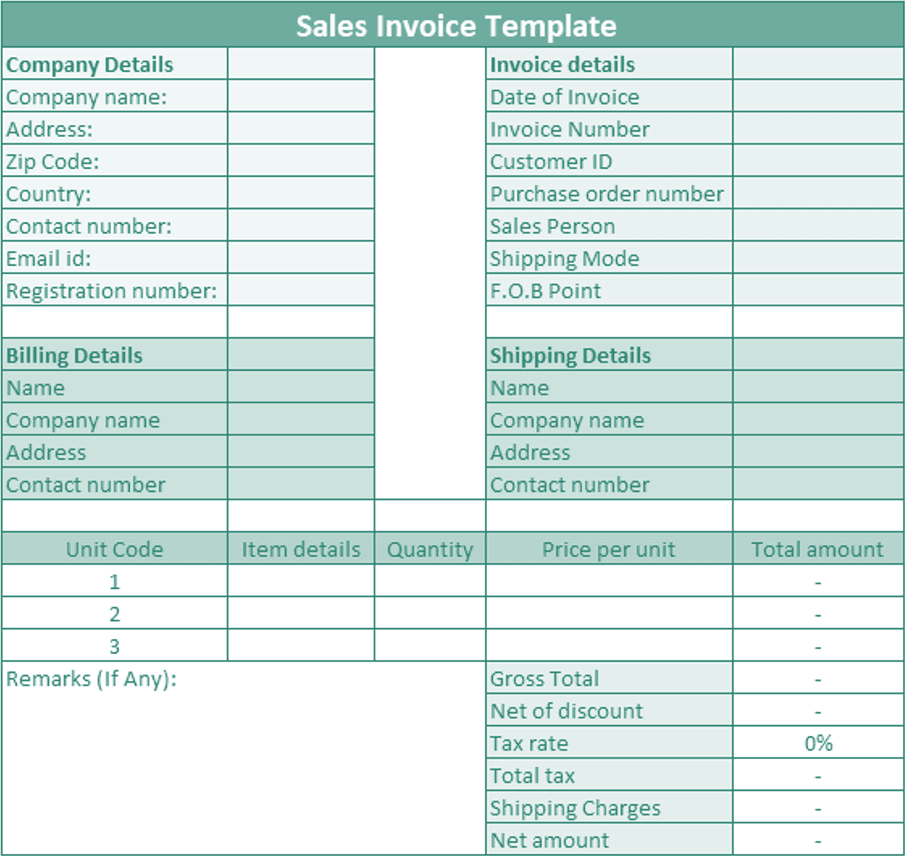Table Of Contents
Free Template of a Sales Invoice
The companies can use a sales invoice template for invoicing their clients. The sales invoice also displays the shipping details and other details like the number of goods sold to the client, the price per unit, the transaction date, and so on.
One may use it to evaluate the actual bill the customer will need to pay in exchange for the products or services he has recently purchased from the company.

About the Sales Invoice Template
- The template can be used by the client as a document proof if, in any case, the products purchased by him from the seller company are defective or less in quantity or are of different quality, etc. The customer can also use it to avail of the warranty from the supplier or exchange the products he purchased from the latter.
- A template is very resourceful not only for the supplier but for the buyer too. For example, a supplier company can use this template for billing its clients. This invoice will be documentary proof against the exchange of products for availing of the warranty, returning the products, claiming refunds, and so on.
Elements
A free online invoice generator simplifies creating professional invoices quickly. Paired with customizable invoice templates, it ensures seamless formatting, accurate details, and a professional appearance, saving time for businesses and freelancers. An ideal sales invoice template must bear all the following details-
#1 - Header of the Template
The seller company must always provide the template header and name it a ‘sales invoice template.’ Providing the header to a template can make it easy for the users to evaluate the purpose and utility of the template.
#2 - Invoice Date and Number
The users of the template should always make it a point of not forgetting to mention the invoice date and its number. Because it is a sales invoice, failure to mention these details can create a huge uproar for the users.
#3 - Customer id and Purchase Order
The seller must also mention the unique customer id issued for each client and other details like the purchase order and his maximum due date of payment to ensure that tracking the client’s payment status is not a task for the company.
#4 - Company's Details
The seller must provide its name, address, phone number, registration number, fax, and email id in the sales invoice so that the client, especially the new clients, can have full faith in the company's genuineness.
#5 - Customer's Details
The details of the clients are also substantial for the company to provide. For example, the sales invoice might be issued to two companies if the billing and shipping are for two different companies. However, it might also happen that both these companies are the same. Therefore, the company must offer client details like name, address, company name, and contact number.
#6 - Sales Person, Shipping mode, and FOB Point
Once mentioning all the details discussed above, the seller will need to provide various other details like the salesperson's name, PO number, shipping mode, and FOB point.
#7 - Sales Description
One must mention the transactions initiated with the customer with due care. They must provide the sales date, serial number, description, quantity, and price per unit to calculate the final total that the customer will be required to pay for the purchases he has made with the company.
#8 - Line totals, Subtotals, and Final Total
The user must evaluate the line total by multiplying the number of purchased products and their price per unit. Then, one must add all these line totals to arrive at the sub-total. The subtotal should then be applied with the tax and shipping charges (if any) to arrive at the final total the client will need to pay.
How to Use this Template?
Following are the steps to use the template:
- A person using the sales invoice template has to enter all the details as required in the fields that are not already pre-filled.
- Firstly one must mention the details about name, address, zip code, country, contact numbers, email id, and registration number along with the invoice number and the date of invoice.
- Once filling in all these details, he must fill in his customer's or client's details like name, address, zip code, country, contact numbers, and email ID.
- Once all these details are provided adequately and cross-examined, the user must forward to the billing segment, where he must mention the date on which the transactions took place, description along with the number of products or services, the price per unit, and accordingly evaluate the line total for each transaction. They can ascertain the line total by multiplying the price per unit by the number of products and services.
- Once providing all these inputs, the line total calculates automatically, but the user must cross-verify all these details and calculations. One must add all the line totals to arrive at the subtotal, and one must add the taxes to arrive at the final amount. The invoice must be duly authorized and provided to the client. Once the payments are clear, the seller must mention paid in the same.


